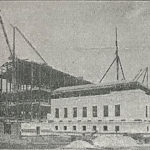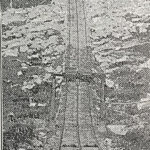By Mary Gilbert Smith
Mount Aeolus, also called Dorset mountain and Green Peak, might have been appropriately named Marble mountain. The first marble quarried in Vermont came from the Dorset quarry on one side of it. The quarry was opened in 1785, after many cemetery headstones had been split from the mountain ledges. The first important contract was secured in 1836 for the Custom house in Erie, PA.
There was little machinery in those days, and it was a real undertaking to get out marble for a building by hand. When the marble blocks were finished they were hauled by team to Whitehall. Although the distance was only 30 miles, it took three or four days to make the trip. The marble went to Albany by the Champlain and Hudson canal and by lake boat to its destination at Erie. The building justified the work lavished on it, for it is still standing and in excellent condition.
On the other side of the mountain is the Danby Imperial quarry, which was opened later, but has been worked extensively in the past 25 years. From it came the marble for the Arlington Memorial Amphitheatre at the National Cemetery at Arlington, the Red Cross group of buildings in Washington, the Institute of Art, Public Library and Scott Memorial Fountain in Detroit and many other buildings in different parts of the country. Largest of them all is the Supreme Court building, now being built in Washington with marble from the Danby quarry.
This building stands opposite the Senate wing of the Capitol, and will occupy an entire block. It is 385 feet long and 304 feet wide. The site was selected by the late Chief Justice Taft, who was the first chairman of the commission. His place on the commission as well as in the court has been taken by Chief Justice Hughes. The other members are: Willis Van Deventer, Henry W. Keyes, James A. Reed, Richard N. Elliott, Fritz G. Lanham and David Lynn. It is expected that the total cost of land, building and furnishings will be close to $11,500,000.
The exterior of the building will be completed this year. No date has been set for the finishing of the interior. It will be the largest and most important of the many famous that have been built of Vermont marble.
The walls call for 700 carloads of the snowy marble for which the quarry is noted. Much of it must be produced in enormous blocks. The 80 blocks used for the drums that compose the 16 fluted columns by the entrance weighed about 25 tons each when they left the quarry. The four blocks for the entrance buttresses weighed about 63 tons.
The quarry is high up the mountainside, about 900 feet above the level of the railroad. Although the entrance is comparatively small, the floor covers several acres. A cable road nearly a mile long takes the rough blocks down the mountainside to the railroad, which carries them to the finishing shops in Proctor.
The cable road goes straight up the slope. The driving road, which is some distance north of it, winds over the face of the mountain and offers no difficulties to a driver accustomed to dirt roads.
The edge of the quarry seems near the top o’ the world, with its sweeping views of mountain and valley. It is reached by a winding footpath at the end of the road. Apparently, the mountain’s supply of marble is endless, for ledges are everywhere.
One hundred and eighty men are now working night and day in shifts that make each gang put in six nine-hour days a week. Seventy of the men drive to the quarry from other towns. Others have homes nearby and the rest are cared for by a boarding house not far from the end of the road.
Parking space along the narrow road between it and the quarry is at a premium. A car stands in every spot that affords room enough to turn around and start down the mountain. Many of them are of the type renowned for service on mountain roads and their ability to “turn around on a postage stamp.”

